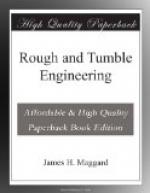Q. Would you ever throw water in the fire box? A. No. It might crack the side sheets, and would most certainly start the flues.
Q. You say, in finding low water while on the road, you would run your engine with the front end on high ground. Why would you do this? A. In order that the water would raise over the crown sheet, and thus make it safe to pump up the water.
Q. While your engine was in this shape would you not expose the front end of flues’? A. Yes, but as the engine would not be working this would do no damage.
Q. If you were running in a hilly country how would you manage the boiler as regards water? A. Would carry as high as the engine would allow, without priming.
Q. Suppose you had a heavy load or about all you could handle, and should approach a long steep hill, what condition should the water and fire be to give you the most advantage? A. A moderately low gauge of water and a very hot fire.
Q. Why a moderately low gauge of water?
A. Because the engine would not be so liable to draw
the
water or prime in making the hard pull.
Q. Why a very hot fire?
A. So I could start the pumps full without impairing
or
cutting the pressure.
Q. When would you start your pump?
A. As soon as fairly started up the hill.
Q. Why? A. As most hills have two sides, I would start them full in order to have a safe gauge to go down, without stoping to pump up.
Q. What would a careful engineer do before starting to pull a load over a steep hill? A. He would examine his clutch, or gear pin.
Q. How would you proceed to figure the road speed of traction. A. Would first determine the circumference of driver, then ascertain how many revolutions the engine made to one of the drivers. Multiply the number of revolutions the engine makes per minute by 60, this will give the number of revolutions of engine per hour. Divide this by the number of revolutions the engine makes to the drivers once, and this will give you the number of revolutions the drivers will make in one hour, and multiplying this by the circumference of driver in feet, and it will tell you how many feet your engine is traveling per hour, and this divided by 5280, the number of feet in a mile, would tell you just what speed your engine would make on the road.
Things handy for the engineer ____________
The first edition of this work brought me a great many letters asking where certain articles could be procured, what I would recommend, etc. These questions required attention and as the writers had bought and paid for their book it was due them that they get the benefit of my experience, as nothing is so discouraging to the young engineer as to be continually annoyed by unreliable and inferior fittings used more or less on all engines. I have gone over my letter file and every article asked for will




